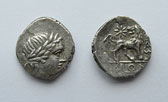|
|
Economy
Miletus was a famous commercial centre. The city was wealthy, already from the Prehistoric period, thanks to its privileged position, as it was the gate of the East to the West and vice versa. Its key position in the relations between the two worlds was further consolidated.  Already from the 8th century BC the Milesians launched feverish activities of colonisation in the Black Sea and the Propontis. The causes of Miletus' intense colonising activity must be sought in a combination of factors. An increase in population became manifest during this period and Miletus, like other cities, proceeded to found colonies, both to decongest cities and to solve social and political conflicts by deporting the dissatisfied ones. Particularly important was the mercantile exploitation of the colonies, as confirmed by the fact that locations chosen were rich in raw materials (metals, wheat, timber, fishing). Ancient sources report somehow excessively that the Milesians founded 90 colonies, which scholars reduce to about 40. However, even this number is very impressive. Moreover, the Milesians played an active role in the trade with the West, maintained their relations with Sybaris and participated in the foundation of Naukratis in Egypt. Already from the 8th century BC the Milesians launched feverish activities of colonisation in the Black Sea and the Propontis. The causes of Miletus' intense colonising activity must be sought in a combination of factors. An increase in population became manifest during this period and Miletus, like other cities, proceeded to found colonies, both to decongest cities and to solve social and political conflicts by deporting the dissatisfied ones. Particularly important was the mercantile exploitation of the colonies, as confirmed by the fact that locations chosen were rich in raw materials (metals, wheat, timber, fishing). Ancient sources report somehow excessively that the Milesians founded 90 colonies, which scholars reduce to about 40. However, even this number is very impressive. Moreover, the Milesians played an active role in the trade with the West, maintained their relations with Sybaris and participated in the foundation of Naukratis in Egypt.
Regarding the local production of Miletus, apart from the exceptional pottery (Wild Goat Style I and 2, Fikellura Style), the city was famous in Antiquity for the quality of lamb wool, the well-known textiles and the purple dye.  This reputation continued until the Hellenistic and the Roman period. There was large-scale furniture production as well. In the 5th century BC the beds of Miletus were particularly popular and were considered valuable possessions. Between 434 and 433 BC 10 beds are reported among the offerings to the Parthenon of Athens, which increased to 16 in subsequent years. The distinctively beautiful furniture of Miletus with the rectangular legs and the ornate, rich design was very famous. This reputation continued until the Hellenistic and the Roman period. There was large-scale furniture production as well. In the 5th century BC the beds of Miletus were particularly popular and were considered valuable possessions. Between 434 and 433 BC 10 beds are reported among the offerings to the Parthenon of Athens, which increased to 16 in subsequent years. The distinctively beautiful furniture of Miletus with the rectangular legs and the ornate, rich design was very famous.
In fact, the prosperity of Miletus was mainly based on the rich land the city controlled and the exploitation of its agricultural products. The production of oil, and possibly wine, must have been significant, judging by the widespread Milesian amphorae in the Eastern and Central Mediterranean.
The role of Miletus as the link between the East and the West does not seem to have been influenced by the Lydian and Persian domination in the 6th century BC.  However, after its destruction in 494 BC, the city lost its primacy in Ionia and the Black Sea. The 5th century BC was a period of decline, which continued until the period of the Ptolemaic domination, when Miletus competed with Rhodes and Athens in trading with Alexandria. The fact that Miletus was able to maintain mercenaries and followed an extremely aggressive policy against its allies proves the prosperity of the city. Things did not change when the Romans were involved in Asia Minor. Even towards the late 2nd century BC extensive construction works were carried out in the city. When Augustus (30 BC) consolidated peace, Miletus became again an important commercial entrepot, with merchandise travelling between East and West. The cosmopolitan character of imperial Miletus is evidenced by the fact that a powerful Jewish community existed in the city. However, after its destruction in 494 BC, the city lost its primacy in Ionia and the Black Sea. The 5th century BC was a period of decline, which continued until the period of the Ptolemaic domination, when Miletus competed with Rhodes and Athens in trading with Alexandria. The fact that Miletus was able to maintain mercenaries and followed an extremely aggressive policy against its allies proves the prosperity of the city. Things did not change when the Romans were involved in Asia Minor. Even towards the late 2nd century BC extensive construction works were carried out in the city. When Augustus (30 BC) consolidated peace, Miletus became again an important commercial entrepot, with merchandise travelling between East and West. The cosmopolitan character of imperial Miletus is evidenced by the fact that a powerful Jewish community existed in the city.
|
|